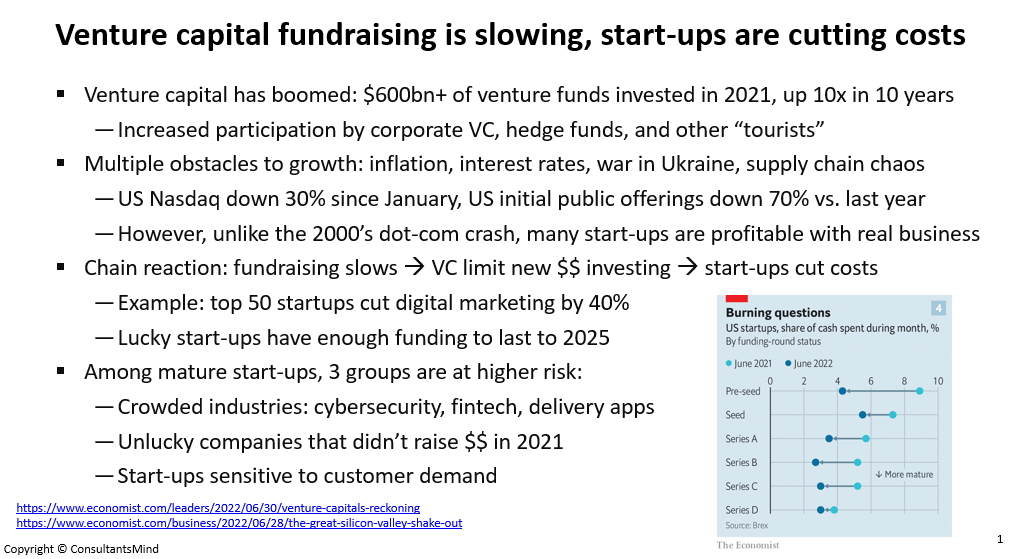One-pagers are super useful
Consultant put their thoughts on PowerPoint. Sometimes, it’s for the final presentation, but much more often, it’s for simple one-pagers. These one-pagers serve a diversity of purposes:
- Checklist of data collection progress and potential bottlenecks
- List of client interviews and initial findings
- Approach for potential survey, benchmarking, client interviews
- Update on project status by workstream vs. milestones
- Tracking of project savings by workstream
It’s worth practicing
In the iconic McKinsey Way, the author talks about “making 1 PowerPoint a day”. Such good advice. Why don’t you give it a try. Take any article from the Economist or any other article and create a slide. Heck, you can even watch 1 episode of Money Heist on Netflix and make a slide out of it. What’s the story you want to tell?
It’s easier to make four pages in PPT vs. just 1. The constraints force you to do the work.
Three steps: what? so what? then what?
Any PowerPoint (even 1 pager) needs a purpose. No one wants to read a high-school level summary of the facts. B-O-R-I-N-G. That’s what Wikipedia is for. Instead, you should answer several key questions:
- What? Succinctly and clearly, tell the reader what the point is. What’s the 1 minute version of the story?
- So what? Why does this matter? It’s a big $$$, or affects a lot of people, or is a changing situation?
- Then what? Okay, what is the call-to-action? What should they be on the look out for?
Organize, think, write, reorganize, edit, write, repeat
This is not a linear process. It should take 20-30 minutes to do well, after finishing the reading. Writing is not 1 thing, it is 4 things: brainstorming, structuring, writing, and editing. Think of it like 4 different hats.
Of course, you should jot down the key points and start “bucketing” them into groups. From there you need to make some decisions about the arc of the story.
- Is it chronological (past, present, future)?
- Are you creating narrative that it is bad now, but don’t worry it will get better?
- Are you sounding the alarm bell for future danger?
Here’s an example of a 1 pager based on 2 Economist articles
In June 2022, the Economist had two articles on venture capital. Find the original articles here:
- Venture capital’s reckoning, Economist, June 30, 2022
- Silicon valley’s great shake-out, Economist, June 28, 2022
Warning, this slide will be text-heavy. More explanation later

A few things you will notice:
- Title should say something. It should be clear
- Each bullet should be self-explanatory; limit the use of acronyms or jumps in logic
- The big bullet points are chronological (2021 was great, obstacles now, 3 groups in potential trouble)
- Data points illustrate the story (e.g., up 10x in 10 years)
- The storyline is a “T”. . . generally broad, covering lots of dimensions with “drill-down” detail at times
This could easily be 3-4 pages
Yes, this is a very text-heavy page. I do find that one-pager are usually a bit more dense because a lot if being conveyed in 1 page. That space constraint forces you to be organized, terse, structured, and edited.
As you can tell from the content and level of discussion, this is likely a page that you should sit across a table and discuss with someone. Definitely NOT a page you should show on a big projector in front of 50 people. The font is Calibri 22 font, and WAY too many words for a “stand and present” storytelling session.
This page was meant to cover the basics and open up the discussion. . .
What could the next page be?
One-pagers serve as a “platform” for the author and the audience to have a conversation. From this initial one page, I could envision future PowerPoint pages, or research, or just a discussion going to this way:
- What are the different VCs doing to mitigate their risks and weather the next few years?
- What is the forecast for VC fundraising for the next 2-3 years?
- What are the potential upside (best case) and downside (worst case) scenarios?
- What kind of startups are having trouble getting funding today?
- For those interested going into venture capital, what should they be doing now?
- What are ways that startups will cut costs? How to help them do that?
- If startups are cutting costs, who will be most affected? (e.g., Facebook advertising?)
- How to identify undervalued investment opportunities, if you are an angel investor?
After reading the 2 Economist articles, anything you would say differently?
